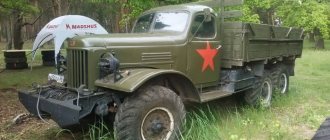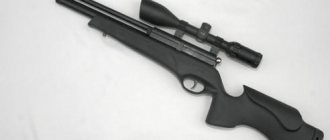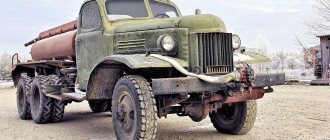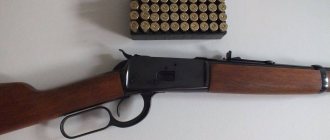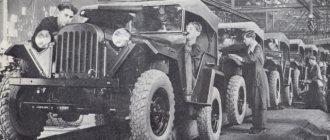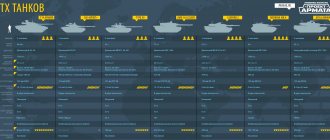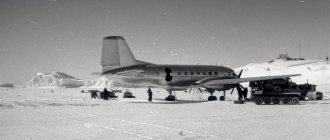ZIL-117
- Soviet premium passenger car with a sedan body. Successor - ZIL-41041 (1986-2000).
ZIL-117 was created in 1971 on the basis of the government limousine ZIL-114 and had the same strict and harmonious forms.
Despite the reduction in length and wheelbase, the silhouette of the car remained swift and elegant, fully consistent with the official image of passenger ZILs. Externally, the ZIL-117 was also distinguished by a different design of the front part of the body.
In addition to black, the car was painted in dark blue and dark cherry colors.
General information about ZIL-117
At the Likhachev plant, the transport was developed as more modern, maneuverable and fast, unlike the previous generation. Despite this, it was rarely used in government motorcades; preference was given to limousines of the 114th version, “Chaika” and “Volga”.
According to some reports, the car was developed according to L.I.’s personal order. Brezhnev. He wanted to get a high-status, but fast car, since he preferred to travel on the roads of Moscow without a driver. Many witnesses in the 70s told how they saw Brezhnev driving his own, shortened ZIL.
The status of the ZIL-117 was considered lower than that of the 114 and 115 models. It was intended for members of the Politburo and the government of the USSR. During the last years of stagnation, these machines were used by the closest assistants of the Secretary General. When Yu.V. came to power. Andropov, this idea was abandoned.
The main versions of the appearance of the ZIL-117
There are three main reasons why the “shortened” limousine was created. None of the three have documentary evidence.
According to the first version, the order for the development of passenger transport was made by the leadership of the 9th Directorate of the KGB. This department was responsible for the security of top officials of the state. The employees needed a maneuverable, fast and comfortable car, which would make it easier to perform security duties. The version raises many doubts, but the main one is the release start date (5 years later than the standard 114th generation). If there was a real need, shortened modifications were produced in small series in parallel with limousines.
The next “myth” is personal dissatisfaction with the dimensions of L.I.’s executive car. Brezhnev. In 1966, at a show of the final versions in the Kremlin, the Secretary General expressed dissatisfaction with the chief designer regarding the size. He believed that the dimensions deprived the driver of the pleasure of driving the car. This overlaps with rumors that Brezhnev wanted a fast car that he could drive himself. To satisfy the needs of the first person of the Union, several individual copies could be collected without spending money on serial production.
The most truthful version is considered to be a struggle at the top of political power. Candidates for Politburo membership were content with the outdated Chaikas, which were inferior in appearance and characteristics to the ZIL-114. Since external attributes were gaining importance in power at that time, officials of the second political echelon did not want to yield to the top officials of the Union. Therefore, the “117th” was put into development. This version is questionable, since members of the Politburo could not make government orders of such magnitude.
Tests and testers
"5/25" means the fifth rank, the 25th rate. I think most people understand what the fifth category is, but just in case, let me remind you that in the Soviet system, the qualifications of working personnel were divided into 6 categories, where 1 was initial, 6 was the highest, more or less respected categories were considered no lower than 4. Since I was a certified specialist at that time, I was immediately assigned the fifth category, and three months later, after receiving permission for road tests, the sixth.
Now about the rates: the 25th tariff rate determined the amount of payment for mock-up work, test tasks on the territory of the enterprise, work in the climate chamber; The 27th rate was awarded for work on public roads and the highest 29th - tests with a risk to life, health and training with drivers of the GON - Special Purpose Garage.
Thus, the coolest test driver is the one who is “6/29,” which I became in the sixth month of work. In addition to the drivers, the bureau team consisted of management, leading engineers, research engineers and instrument technicians. In those years, the “old people” who stood at the origins began to leave. Some retired, and some younger ones found employment in representative offices of foreign companies or opened their own businesses, and the path to a quick career was open for young specialists at the plant, but the salary left much to be desired and was the main reason for the terrible turnover of personnel even in such an elite division. However, this did not prevent the formation of a friendly team; I still communicate with many of my then colleagues. Although, unfortunately, we all haven’t experienced huge black limousines with a “sight” on the hood for a long time...
Design of ZIL-117
The ZIL-117 car is a good modification of the “114th”. Much is similar in external design, interior trim and technical characteristics.
The first difference in the interior is that the back row is moved closer to the front row to reduce the length. Despite this, the comfort of the passenger seats has not deteriorated. This step saved half a meter of length. The interior decoration has been preserved. The designers planned to make the body load-bearing, but because of this they would have to develop everything from scratch and install frame reinforcements. This would lead to an increase in the weight of the car. To solve the problem, engineers replaced the peripheral frame with a stamped-welded ladder frame.
The wheelbase has become shorter by 48 centimeters. Shortening elements such as the body, driveshaft, piping and wiring allowed us to save another half a meter. There are no more differences in the hardware compared to the “big brother”.
The ZIL-117 engine remained unchanged. Eight-cylinder engine with V-shaped cylinder arrangement. It had impressive characteristics: 300 horsepower, allowing it to accelerate to 190 km/h. The design of the power plant was complemented by a four-chamber carburetor, a hydraulic valve lifter and a transistor ignition system. The two-speed automatic transmission with torque converter has been retained. In 1975, it was replaced by a three-stage GMP.
The suspension has not undergone any changes. It provides a smooth and soft ride on asphalt and unpaved roads. The main feature of the suspension design is the anti-roll bar and torsion bars, which act as a flexible element. The noise in the cabin is reduced by attaching the suspension to the frame using rubber hinges.
The brake system consists of two circuits. Each one works with a pair of pads on wheels located diagonally relative to each other. This was done to increase safety: if one of the circuits breaks down while driving, the car could brake confidently. The rear brakes have a force limiter. The vacuum booster complements the brake master cylinder. There are hydraulic vacuum boosters in the contours of the front and rear brackets. The parking brake operates by pressing the pedal. It is based on a mechanical drive. It affects the brake drums of the rear wheels. The parking brake operates when the hydraulics are faulty. When you started driving, the parking brake was automatically released.
The key point of auxiliary systems is servos. Due to them, glass washers, electric windows work, antennas extend, door locks are blocked and the radio is tuned.
Specifications:
- Length - 5.7 meters;
- Width - 1.5 meters;
- Height - 3.3 meters;
- Wheelbase - 3.3 meters;
- Ground clearance - 17 centimeters;
- Weight - 3.2 tons;
- Engine capacity - 7 liters;
- Power - 300 horsepower;
- Gearbox - automatic;
- Maximum speed - 190 km/h;
- Fuel consumption is 18 liters per 100 kilometers.
In the cabin, the partition between the front and rear rows was eliminated. Not only the front seats, but also the rear sofa are covered in leather. There are no armrests, so communications and remote controls are placed in a massive structure located between the front wheels. A separate air conditioning system has been implemented: for the driver and passenger areas.
VIP passengers are now accommodated between the rear doors. At the same time, the glass in front of the rear pillars was preserved. The rear pillars had to be made stronger, as their number was reduced from eight to six. The angle of inclination at the leading edge of the rear pillars has changed, which is why the shape of the rear doors has changed. The rear doors are equipped with blind windows.
The wheel arches and the edges of the rear wings received a new decorative element - chrome moldings. The basic design from the 114th model was retained, as it met modern premium class requirements. Despite the reduction in length by half a meter, the appearance of the transport did not deteriorate, but only sparkled with new colors. The shortened version differed from the “limousine” in its ease and everydayness, although it performed the same role - transporting top officials of the state. For ordinary citizens, the “114th” seemed unattainable, and the ZIL-117 model was defined as a car that could be used on a daily basis.
Vehicle equipment
The equipment of the ZIL-117 could be the envy of a modern high-class car. And in terms of the level of luxury and interior comfort, as well as its driving performance, it would give odds to its contemporaries such as Bentley and Rolls-Royce.
Even if we do not take into account the fact that each future “owner” of the car could order an individual interior trim, the car had excellent factory equipment, even by modern automotive standards.
In addition to a powerful three-hundred-horsepower engine, the car had:
- automatic transmission;
- steering with hydraulic booster, and the steering wheel could be tilted for the convenience of the driver;
- air conditioner;
- determal (heat-absorbing) glasses with a greenish tint;
- power windows equipped with electric drives;
- door locks with central locking;
- wheel suspension equipped with a system that prevents “nose dive” when braking and reduces body roll when cornering;
- ABS.
The car's chassis was based on a reinforced frame with a high torsional rigidity coefficient.
ZIL-117V
ZIL-117V is an open version of a luxury car, which was developed not on the basis of a “limousine”, but on a shortened version of it. Despite copying the analogue, the modification with the “B” index received many distinctive features.
The first problem that the developers encountered was deteriorated body rigidity due to the elimination of the side and rear pillars. To eliminate the shortcoming, each panel was equipped with its own additional amplifier. The frame remained the same - stamped-welded ladder type. For the first time, rigidity criteria were applied to the doors of the “open version”.
In the few years that have passed since the release of the classic version of the ZIL-117, design trends have changed slightly. The phaeton received four round headlights placed in a square frame covered with chrome. In addition, the design includes a chrome radiator trim with a pattern and open rear wheel arches.
The interior arrangement was retained from the sedan. The interior is trimmed with high-quality leather that has served for many years. Communication devices and remote controls have again changed their location - they were moved to a special console, which is located between the front seats.
Specifications:
- Length - 5.7 meters;
- Width - 2 meters;
- Height - 1.5 meters;
- Wheelbase - 3.3 meters;
- Ground clearance - 17 centimeters;
- Weight - 3.3 tons;
- Engine capacity - 7 liters;
- Power - 300 horsepower;
- Gearbox - automatic;
- Maximum speed - 190 km/h;
- Fuel consumption is 18 liters per 100 kilometers.
The main purpose of the vehicle is demonstration at parades. For this purpose it was equipped with a microphone and a radio station. The front passenger seat was removed and was replaced by a stand that a standing person could hold on to. The body was painted gray-green, the awning light gray. The Likhachev plant assembled three copies. It first appeared on Red Square in 1972, after which it participated in all military parades until 1980. “B” was replaced by ZIL-41044. The technical equipment is the same as that of the sedan version.
Around the capsule and TB
It has long been no secret that the ZIL used a unique armor technology - the car body was built around a volume-bearing armored capsule manufactured at a military plant in Kurgan.
The service life of the capsule exceeded the service life of the body, so the car, written off from the Special Purpose Garage, was returned to the factory, where a new body was made around the old capsule. In addition, the armored version had multi-layer self-tightening fire and explosion-proof fuel tanks. Naturally, such work was incredibly expensive for the state budget (in total, 25 armored capsules were manufactured, which were used in the construction of about a hundred cars and two for ballistic tests).
In the mid-1990s, the customer set a new task: in addition to traditional armor, to develop a cheaper armored version, albeit with a lower protection class, but using traditional technology for using protective armor plates in the most vulnerable affected areas. The German company Trasco Bremen got down to business, producing 3 prototypes that received the index 41047TB (Trasco Bremen). After testing these cars by the customer, all of them were returned to the factory due to unsatisfactory body rigidity, leaky handling and directional stability, as well as insufficient braking system efficiency. Our factory bureau had to return these cars to service. In essence, this meant modifying the frame, chassis and braking system of the “light” 41047, which was suddenly loaded with armor plates. In general, voluminous technical information about these exclusive one-piece cars is now available in many open sources; there are even individual drawings on the World Wide Web! That is why, perhaps, it will be more interesting to recall a few everyday life from the life of test drivers of the AMO ZIL passenger bureau.
